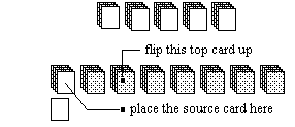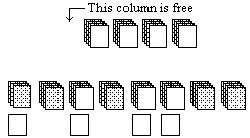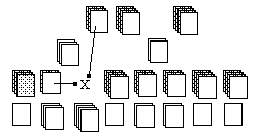There are 13 stacks of 4 cards each, on the deal.
Rows 1 and 2 together form the upperwalk
Rows 3 and 4 form the lowerwalk

| BWS Home | Concepts/Terms | Goofy | |
| The download includes a text-only copy of the instructions | |||
Boardwalk Solitaire offers a challenging and original approach to games played with a standard 52 card deck. It originated with the traditional game of Clock Solitaire, and then it picked up declaration space and ability in Around the World. When it gets to Hopscotch (where BWS begins), the player picks up the ability to declare all of the columns of the board as he/she/or the deal sees fit.
Each variation of Boardwalk Solitaire gives more power to the player, but also increases the potential challenges. Rules for each variation are not restated in each successive variation, but they do continue to apply. Wherever labeled, "Note of Interest", the paragraph can be skipped without missing necessary details on rules.
|
We start with the rules and abilities for Hopscotch, which includes:
|
And this leads us on to new capabilities with advanced varations:
|
|
There are 13 stacks of 4 cards each, on the deal. Rows 1 and 2 together form the upperwalk Rows 3 and 4 form the lowerwalk | 
|

The above diagram adds dividing lines to indicate the 13 distinct columns of the board. As the player, you will select the face-value to stack upon each of these columns. These will be your declarations.
The stacks on rows 1 and 3 are always referred to as source stacks, each capable of being topped by a face up card (available for play).
The destination rows (2 and 4) begin void of cards, and cards played upon them score one point apiece at the end of the game.

Once you have declared a column, it will be playable by cards of that face-value only.
Note of Interest: The use of columns is a departure from the previous games, Around The World, and Clock Solitaire. In those instances, we did not physically separate the source and destination locations, because we did not have a need to do so. Cards played stacked neatly, face up, beneath their respective source stacks. But for these games, each time we play we will invariably vary our arrangement of face values, and with this physical layout we will always see how our cards are presently arranged.
top
Depicted above is a sample live play. A lowerwalk column receives a card, and by being the first card received upon that column, in this example the column is declared playable by cards of that face value only.
When playing live (a lowerwalk column), you must also flip the top card of its source stack up, in place. As depicted above, the leftmost column of the lowerwalk will do this. When this occurs, the column becomes blocked (as pictured below). The column cannot be played to live again until the blocking card is removed (pictured far below).

Continuing with the previous example, above is a live play from the lowerwalk. Below is how the board appears after the play. Always remember to flip on the column that is played to (and not from).

A lowerwalk column can be played by its own blocking card, since the block is removed in the act of initiating the play.
At this point, it may seem like, "Gee, this is too easy". Well, you're right - this is too easy! Where Aces are low and Kings are high, the lowerwalk columns must be declared in ascending order from left to right. Now it might not be considered "too easy". As the player, you still get to pick and choose (from the remaining possibilities) which face value goes where, across the lowerwalk.
topOn the upperwalk columns, the source stacks are feeder stacks. When a card is removed from one, the next flips up in its' place. The destinations, however, begin blocked for play, as it turns out, by the very existence of their respective source stacks.
In this example, all of the cards from the leftmost source stack have been cleared out.

In order to declare an upperwalk column, you must first clear it's source stack, at which time you can then declare and file your choice of face value (upon it's destination).
In Hopscotch (and in Lucky Seven), the columns of the upperwalk do not have to be declared in any particular order, from left to right.

In the above example, X is the face value declared on the leftmost column. Source cards of value X are then simply filed on top of it as they arise.
An upperwalk column can be declared with its own last source card, since its block is removed in the act of initiating the play.
Note of Interest: The face values that wind up being filed have become known as dead cards. These are the cards that have not been able to find (or be given) homes on the lowerwalk.
topThere is one other legal play available.

|
Well into its development... All of the lowerwalk columns have been declared. Two of the upperwalk source stacks have been emptied, and their respective destinations have been put to use. An opening on the lowerwalk source row for slides has appeared. |
In this example, there is a spot marked "X" on the lowerwalk source row, and it holds no cards. You can slide any one (face up) source card to this spot. To create such an opening on a lowerwalk column, you must first play out four-of-a-kind upon it.
Any one slide opening can hold no more than one up card at a time.
Dealt as one five column upperwalk, one seven column lowerwalk, and one four card hand.
Lucky Seven gives the player the ability to interact with the lowerwalk using a four card hand. Cards in the hand which cannot play upon any of the seven columns of the lowerwalk stay in the hand for the rest of the game. Lucky Seven is, in my opinion, noticeably easier to win than Hopscotch, and it tends to be regarded as the most recreational of the Boardwalk Solitaire bunch.
The hand play, potentially occuring in three distinct ways, will always follow the same basic mechanical format. A card from the hand plays live (causing a flip and a block upon) a lowerwalk column, and a card from the lowerwalk source row is returned to the hand.
Basic (blocked) Hand Play: When playing a blocked column from the hand, the player returns the blocking card to the hand, which allows for the next source card of the column played to flip.
Power Play: When playing a column that is not blocked, the player has the freedom to gather, as the return card to the hand, any one (blocking) card from the lowerwalk. Remember to flip on the column played.
Blind Play: When playing an unblocked lowerwalk column from the hand, and prior to witnessing the card that is to flip upon it, the player elects to return the flip card to the hand.
The hand score is a card count of its most frequently occuring face value. Four-of-a-kind scores four points. Less than a pair garners one. For a perfect game, aim for four-of-a-kind in the hand.
topIn addition to all of the rules of Lucky Seven, hand cards may now play upon the Upperwalk. With all of the control the player has over the cards in Squattsi, it is easier as a game to win, and so the following stipulation is added: The upperwalk columns must be declared in ascending order from left to right, which balances things out and makes Squattsi, as compared to Lucky Seven ,"on par" in it's ease of winning, but more challenging to play.
Note of Interest: With the combination of two, separately ascending walks, 12 face values of the deck will have to fit together more neatly on the board. As in Lucky Seven, the 13th (remaining) face value needs to be gathered in the hand.
A card is played from the hand to an upperwalk column, and possibly even to its' row 1 (source stack) position. From the player's choice of row 1 stacks, a face up card is then returned to the hand. If there are no more cards on row 1, then the upperwalk can no longer be played upon by the hand.
Trump: If the column played is to be legally declared or filed upon, i.e. its' source stack is at least empty, the player may trump by playing from the hand to that column's destination, returning any one face-up card from row 1 to the hand.
Juggle: If the source and destination, i.e. one upperwalk column, is entirely void of cards, the player may choose to play from the hand to that column's source location, and return to the hand as before. This is called juggling, because it trades a card in the hand with a card from row 1. (The card played from the hand to row 1 is then available as source for further play.)
Since a card can be played from the hand to row 1 (juggled) without having caused any other card on the board to flip, another opening for juggling could allow the player to juggle back and forth perpetually. In avoidance of this, a card played to row 1 from the hand cannot from that time forward be gathered back into the hand until one other card (anywhere) on the board flips.
topThe walks in Cheshire are resized to 6 columns apiece, which makes this game more challenging in that respect, but cheshire begins with four upperwalk source stacks which may be coaxed. I believe that Cheshire can be won most of the time, when played very carefully.
Four of the source stacks in Cheshire start with all cards face down. The act of flipping up the top card of an upperwalk source stack is taking a favor.
In Cheshire, prior to an upperwalk column's declaration, a card can be played from the hand to the top of that column's source stack, where that source stack is not presently topped by a face up card. The player's choice of upperwalk source card is then coaxed back to the hand.
top